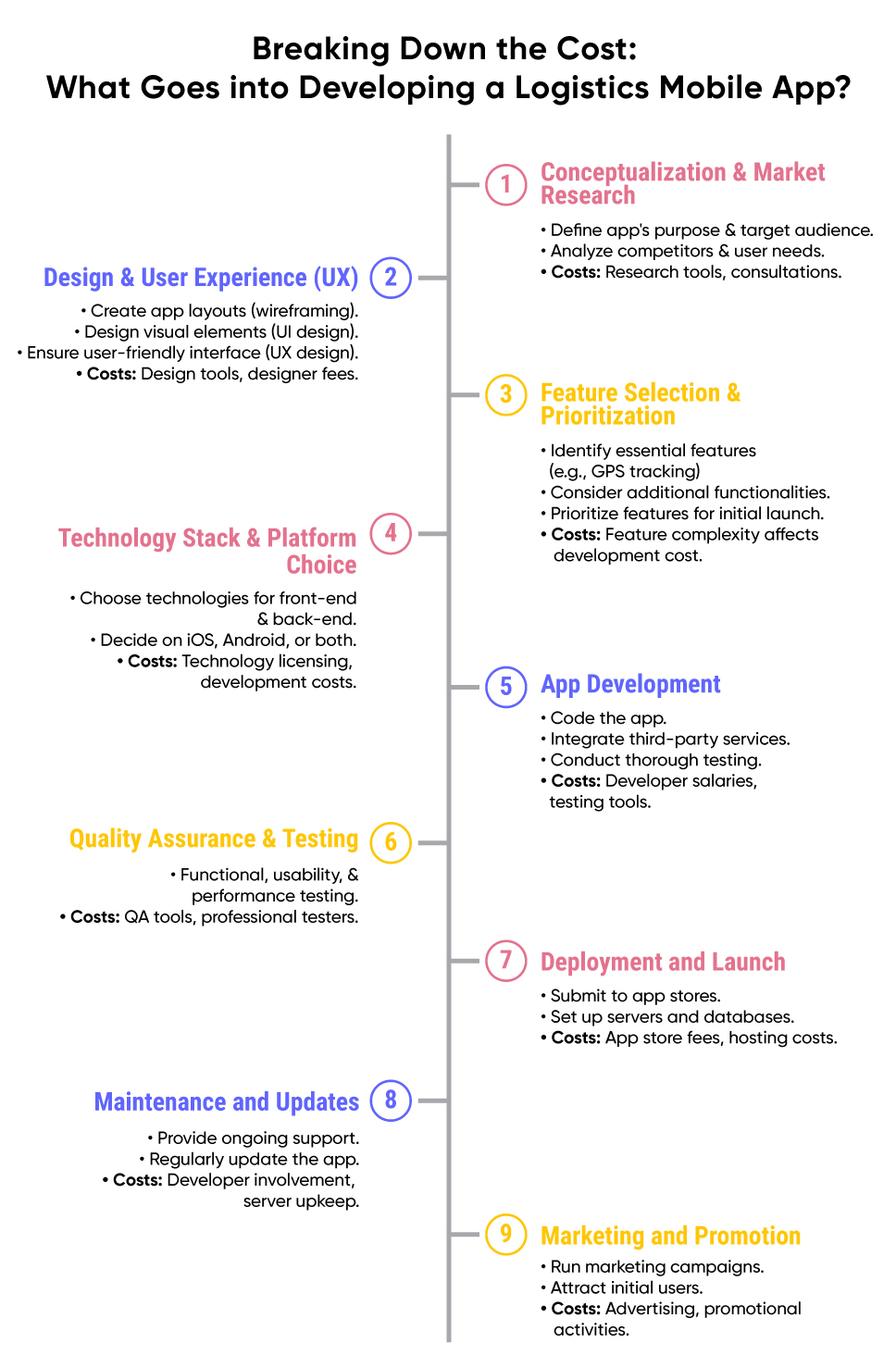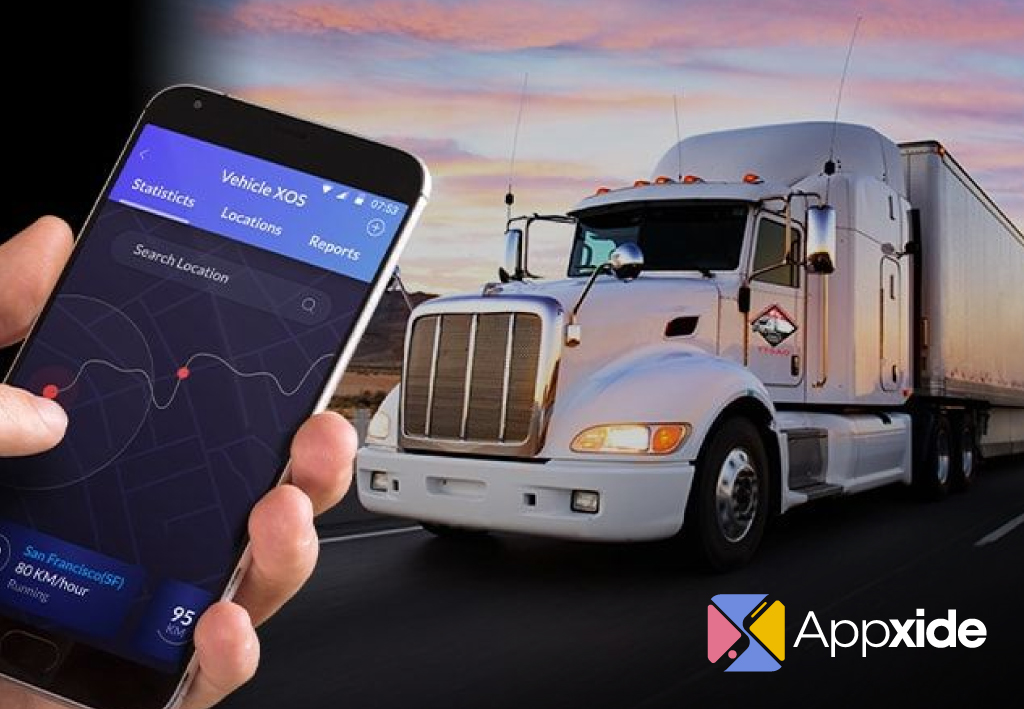Businesses are constantly seeking ways to streamline operations and enhance efficiency. The logistics sector, being no exception, has witnessed a paradigm shift with the advent of mobile applications. Understanding the cost implications of developing a logistics mobile app is crucial for companies looking to invest in this digital transformation. In this post, we dive deep into the logistics mobile app development cost, breaking down the various factors that influence it, and providing you with a detailed roadmap to navigate this complex terrain.
The Significance of Mobile Apps in Logistics
Before we check out the costs, let’s understand why logistics companies are increasingly turning towards mobile apps.
- Real-time Tracking: Mobile apps offer real-time tracking of shipments, ensuring transparency and enhancing customer satisfaction.
- Efficiency and Productivity: Automation of tasks and better route planning leads to increased operational efficiency.
- Data-Driven Decisions: Apps provide valuable insights through data analytics, aiding in informed decision-making.
Core Features of a Logistics Mobile App
A logistics app is more than just a tool for tracking; it’s a comprehensive solution that encompasses various functionalities. Here are some must-have features:
- Shipment Tracking: Real-time updates on the location and status of shipments.
- Inventory Management: Efficient management of inventory levels and warehouse operations.
- Route Optimization: AI-powered algorithms to determine the most efficient routes.
- Document Management: Easy access to transport documents and invoices.
- User-Friendly Interface: An intuitive design for seamless user experience.
Breaking Down the Cost
Now, let’s get to the crux of the matter: logistics mobile app development cost. Here’s where it gets interesting, as several factors come into play.

Platform Choice
The choice between Android, iOS, or a cross-platform solution significantly impacts the cost.
- Android & iOS: Developing for both platforms separately can be costly but offers optimized performance.
- Cross-Platform: A cost-effective solution that ensures broader reach with a single codebase.
App Complexity
The complexity of your app directly influences the cost.
- Basic App: Features like GPS tracking and simple user interfaces.
- Moderate Complexity: Integration with existing systems, customized features.
- High Complexity: Advanced features like AI, ML algorithms, and IoT integration.
Design and User Experience
A visually appealing and easy-to-navigate app is crucial but adds to the cost.
- Standard Design: Basic templates with standard user interface components.
- Custom Design: Unique designs with advanced UI/UX elements.
Development Team
The geographic location and expertise of your development team play a significant role.
- In-house Team: Higher costs but better control over the development process.
- Outsourced Team: Cost-effective, but requires careful selection to ensure quality.
Maintenance and Updates
Post-launch maintenance and regular updates are essential for the app’s longevity.
- Routine Maintenance: Regular bug fixes and minor updates.
- Major Updates: Addition of new features or significant changes to existing ones.
A Closer Look: Cost Breakdown Table
To give you a clearer picture, let’s break down the costs into a comprehensive table:
| Feature |
Basic App |
Moderate Complexity |
High Complexity |
| Platform Choice |
$5,000 – $10,000 |
$15,000 – $25,000 |
$30,000 – $50,000 |
| App Complexity |
$10,000 – $20,000 |
$25,000 – $40,000 |
$45,000 – $70,000 |
| Design and User Experience |
$3,000 – $5,000 |
$6,000 – $10,000 |
$12,000 – $20,000 |
| Development Team |
$15,000 – $25,000 |
$30,000 – $50,000 |
$55,000 – $80,000 |
| Maintenance & Updates |
$2,000 – $4,000 |
$5,000 – $8,000 |
$10,000 – $15,000 |
| Total |
$35,000 – $64,000 |
$81,000 – $133,000 |
$152,000 – $235,000 |
Factors That Can Skyrocket Your Budget
Beware of these budget busters that can significantly increase the development cost:
- Frequent Changes: Constantly changing requirements can lead to increased costs.
- Complex Features: Advanced features like AI and blockchain integration are costly.
- Poor Planning: Lack of clear objectives and planning can lead to unnecessary expenses.
Cost-Efficient Strategies for Development
To keep your budget in check, consider these strategies:
- MVP Approach: Start with a Minimum Viable Product and gradually add features.
- Choose the Right Team: Select a development team that offers a balance between cost and quality.
- Effective Planning: A clear plan and well-defined requirements can save both time and money.
User Engagement and Retention Strategies
Once your logistics mobile app is launched, the focus shifts to one of the most critical aspects of its lifecycle: user engagement and retention. Engaging users and ensuring they return to your app is vital for sustained success. Here, we explore effective strategies to keep your users hooked and loyal to your logistics app.
Understanding Your Audience
- User Research: Conduct surveys and gather feedback to understand user preferences and pain points. Tailoring your app to meet these needs increases relevance and user satisfaction.
- Segmentation: Divide your user base into segments based on behavior, usage patterns, and preferences. This allows for more targeted and effective engagement strategies.
Personalization
- Custom User Experiences: Use data analytics to offer personalized experiences. For instance, remembering past shipments and preferences saves users time and enhances usability.
- Push Notifications: Smartly crafted, personalized push notifications can remind users of your app’s value. For instance, timely updates about shipment status or special offers based on user interests can boost engagement.
Reward and Loyalty Programs
- Incentives: Implement reward systems for frequent usage, like discounts on future services or exclusive features for regular users.
- Loyalty Programs: Create a loyalty program that rewards long-term users. This could include tiered benefits, encouraging users to continue using your app for more significant rewards.
User Feedback and Continuous Improvement
- Feedback Channels: Establish easy and accessible channels for users to provide feedback. This can include in-app surveys or feedback forms.
- Act on Feedback: Regularly update the app based on user feedback. Demonstrating that you value and act on user input can significantly enhance user loyalty.
Educational Content and Support
- Tutorial and Guides: Provide comprehensive tutorials and guides within the app. Helping users understand how to get the most out of your app can increase engagement.
- Responsive Support: Offer quick and helpful customer support. Efficient problem resolution is often a key factor in retaining users.
Regular Updates and New Features
- Feature Updates: Regularly introduce new features and improvements to keep the app fresh and engaging.
- Announcements: Make sure to communicate these updates to your users through in-app messages or emails, creating anticipation and renewed interest.
- Social Features: Implement social features where users can share their experiences or tips. This could include a community forum or integration with social media platforms.
- User Generated Content: Encourage users to share their experiences, which can be featured in the app or on social media. User stories and testimonials can foster a sense of community.
Monitoring User Behavior
- Analytics: Use analytics tools to monitor how users interact with your app. Understanding which features are most and least used can guide your future development efforts.
- Adaptation: Be prepared to adapt your strategies based on user behavior trends. Flexibility is key to staying relevant in the ever-changing app market.
FAQs of Logistics Mobile App Development Cost
What is the usual time period for creating a logistics app?
It ranges from 3 to 9 months, depending on the complexity and features.
Can I develop a logistics app for both iOS and Android simultaneously?
Yes, using cross-platform technologies can enable simultaneous development.
How often should I update my logistics app?
Regular updates every 2-3 months are recommended to keep the app relevant and efficient.
Is it necessary to include AI and ML features in a logistics app?
While not mandatory, these features can significantly enhance efficiency and user experience.
How can I ensure the security of my logistics app?
Invest in robust security measures like SSL encryption, secure APIs, and regular security audits.
Conclusion
Understanding the logistics mobile app development cost is a complex but essential step in your digital transformation journey. By considering the factors outlined in this guide and adopting a strategic approach, you can develop an efficient, cost-effective logistics app that meets your business needs and enhances operational efficiency. Remember, a well-developed logistics app is not just a cost; it’s an investment in your company’s future.






